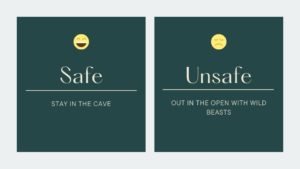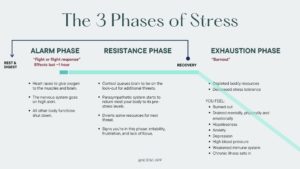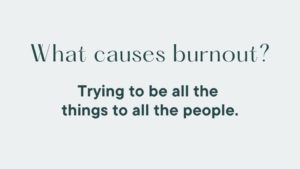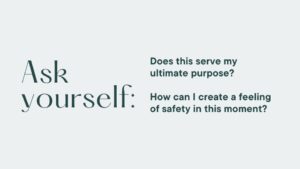GAH, I just can’t do this anymore, I’m just so burned out
You’re not imagining it, your body is sending up all the flares and signals that it can’t keep going. It’s more than an exasperated expression or a poignant statement, it’s a state of being.
While many use the term flippantly, burnout is a very real phenomenon and so are its consequences. I’m going to go into some detail about how the body gets there then how to pull yourself out of the nose-dive and back to balance. Awareness alone is a huge part of resetting your health.
What is burnout?
Burnout is a true state of exhaustion where the body can’t keep up with the constant demand on internal resources and it starts to peter out. Let’s talk about how we get there. There are three phases to stress: The Alarm Phase, The Resistance Phase, and The Exhaustion Phase. Colloquially termed “Burnout,” this final phase leaves us feeling tapped, zapped, fried, and completely drained.
Burnout starts to show up as a short fuse, frustration, exhaustion, brain fog, slow speech, anxiety, depression, sleeping problems, aches, pains, and stomach issues. Sometimes we start to lose hair and our skin goes dull, maybe even patchy.
Emotionally we start to have lack of empathy towards others, we might start to call others ‘lazy’ or ‘stupid.’ You might not be able to ‘switch off’ and start neglecting your personal needs. To cope, substance abuse becomes the norm. Since no one seems to understand your plight, you start to withdraw and feel empty inside. This is only some of it. The laundry list is long.
If unchecked, chronic disease starts to set in. With a kink in your DNA and a predisposition for autoimmune issues, the trigger activates, expressing that gene as rheumatoid arthritis, Hashimoto’s, psoriasis, or one of the 150 (and counting) other autoimmune issues.
Even without a gene expression, autoimmunity can happen when perpetual, unrelieved inflammation is present around a digestion system that has been turned off. The body’s systems become confused and it starts to attack itself.
Modern World. Ancient Body.

Our bodies are brilliant. They’re designed to keep us alive for the long haul. To that end, they’re always out for one thing: survival. The challenge comes when ancient hardware (the body) is being run by the newest software (the brain.) There are parts of us that haven’t evolved very much past our other mammal ancestors. Our super-evolved brains often override a lot of our basic fundamental physical needs to satisfy social or emotional needs. This looks like work over play. Screens over sleep. Toxic relationships over true companionship. Convenience over healthy food.

Phase 1: Alarm
The body goes into the Alarm Phase when it senses danger, thus the “Alarm.” You know this as the flight, fight, or freeze mode. This is controlled by our Limbic System. It regulates autonomic or endocrine function in response to emotional stimuli and also is involved in reinforcing behavior [Did you catch that one? It reinforces what we’re doing to ourselves]. In our modern world we don’t encounter too many wild animals or imminent dangers like we once did, so now our body responds the same way to dings, bings, alerts, angry bosses, traffic jams, screaming kids and other stressors in the same manner as it once did when it was trying not be eaten for lunch.
When your body enters the Alarm Phase, it goes on high-alert and resources are pushed to the body parts that will keep it safe. A surge of stress hormones like cortisol and adrenaline pump to your muscles. Your heart begins to race and your blood pressure raises to open veins and arteries. Your lungs expand to get more oxygen to fuel your cells and muscles. Suddenly all your senses and reaction time is more acute — decision making happens at lighting speed. All of this so we can think and respond as fast as possible to get the hell out of whatever situation we’re in — it was keenly designed to keep us alive.
Cleverly, it also slows or shuts down all other systems to save resources. Digestion is stopped so that all the energy can be pushed to the systems that will keep us alive. Hair and nail growth are definitely not needed to run away from lions, tigers, and bears. But it does all this temporarily, the effects lasting about an hour.
Phase 2: Resistance
The body, being extra smart, knows that when it has sensed one danger, another might not be too far behind. One of the roles of cortisol is to tell the brain to scan for another threat. So, after the passing of the initial stressor, only about 80% of the body goes back to normal, resting and digesting, while the remaining resources are still on alert to help us react fast.
Where it starts to go sideways is when we hijack our limbic system so that we can work tirelessly and produce more output. That adrenaline produces some amazing results and we become addicted to the rush and wind at our back to do better work. When we do this our system gets stuck in something called the HPA axis, which is a feedback cycle where the body can no longer shut itself off. The spigot is stuck in a vicious cycle of continual stress. We produce cortisol and adrenaline which starts to queue our brain to dump even more neurochemicals.
Phase 3: Exhaustion, AKA Burnout
What was once supposed to be an hour in flight or fight becomes weeks, months, even years stuck inside the HPA axis stress loop. The body can’t keep up with production and the body starts to suffer.
This is what we call Adrenal Fatigue, AKA, the modern woman syndrome.
Stick around in this phase too long and guess what sets in: The Exhaustion Phase, or BURNOUT.
We’re often alerted to burnout and adrenal fatigue because the parts of us we can’t hide start to be affected. Remember when our body shut down the digestion, hair, and nail growth to favor helping us? That starts to catch up in the mirror. We lose hair, our skin looks dull. We start to lose or gain weight for no reason. In a society that values beauty, when our outward appearance matches how we feel on the inside is usually when we take note and want to do something about it. In our extreme diet and exercise culture, we typically start here and put ourselves on rigorous exercise regimes and limiting our calorie intakes. We deny ourselves even more of the rest or helpful nutrients we desperately need.
Who burns out?

Anyone, really. A-types, go-getters, people-pleasers, caretakers, civil servants, parents, swing-shift operators, and, most notably but not researched enough — working moms. People who burn the candle at both ends, people who have something to prove or live for other people, often at the expense of themselves. Trauma survivors, BIPOC, and healthcare workers doubly so. What’s extra fun is if you are all the above.
So, what do we do about it?
First, Burnout Awareness.
There are 12 Stages of Burnout. Assess and identify where you’re at on the burnout scale (take the quiz here.) It’s essential to take stock of your life, your relationships, how you feel mentally, physically, and emotionally. Then start getting honest with what you are willing to change. What habits are you ready to ditch and which will you evolve to create lasting health? Most people come into awareness of their own health and burnout only when they’re quite burned out and have hit rock bottom. That’s just how it goes. A lot of people who burn out are headstrong and can’t be told what to do or how to do it and often keep running for the cliff, despite all the warning flags and signs along the way.
Next, let’s look at Burnout Recovery.
People who have been in living in burnout for a while are truly exhausted, depressed, and chronically sick (I speak from experience.) It takes a lot more effort to bounce back from burnout than to catch you before you get there.
Immediate de-stressing is needed. The challenge is that what works for Prevention and Awareness does not work for Recovery. If you’re square in burnout to the point of chronic illness, self-care tools like journaling and meditation usually aren’t enough to bring you back. Most likely you’ll need to work with a holistic professional(s) with different modalities to support you. The most critical thing you can do for your body at this point is to relieve the biggest stressor and get as much sleep as possible. Rest is the key to optimum health. Sleep is where your body repairs itself.
Stop burnout before it starts.
Going beyond self-care.
Burnout Prevention is a lovely idea and one that is being circulated with the popularity of self-care. Self-care is more than just spa days, though. Self-care is about upholding your values and being true to who you are as a person. You’ll need to create and protect your personal boundaries, which can be a challenge for people pleasers.
Stress reduction and stress management tools are different for every person, so you’ll need to find what’s right for you. Here’s a list of my favorite holistic stress management tools. However, the basics are about getting your body and your nervous system to rest, relax, and recover back to feeling safe in a timely manner. It’s all about creating an instant reset button the body can remember and tap into to feel safe again.

The most studied and recognized stress reduction techniques are breathwork and meditation. For me, and those who I’ve coached, it all starts with mindset. When you start to uncover why you push yourself so hard, or put others’ needs before yours, this is where true healing begins. Mindset shifts also allow you to break neural bonds that are developed in a stress response.
It’s important to identify the root cause of your stress triggers so that you don’t repeat patterns and so you can build new, healthy ones. You’ll work to bring mind, body, and spirit back into alignment, and learn to listen and hear your body and what it needs to remain there. Learning to trust yourself and give yourself grace for any setbacks or hiccups along your healing journey will be both a challenge and a reward for you.
Burnout Causes
- Stress
- Unrealistic expectations
- Perfectionism
- Unresolved trauma
- Self-loathing
Burnout Effects
- Poor physical health
- Poor mental and emotional health
- Chronic illness
Burnout Recovery
- Rest
- Mindset
- Food
- Gut and thyroid attention
- Supplements
- Holistic modalities and methods
Burnout symptoms
- Exhaustion
- Constant fatigue
- Sleep disorders
- Reduced performance
- Concentration and memory problems
- Inability to make decisions
- Reduced initiative and imagination
- Aches, pains
- Irritability
- Anxiety
- Depression
- Substance abuse
- Aggressiveness
- Lack of empathy towards self and others
- Inability to switch “off”
- Neglecting personal needs
- Revision of value sets
- Withdrawal
- Behavior changes
- Inner emptiness
- Intolerant to others (perceiving others as lazy, stupid, undisciplined)





